
·主办单位·
长江文化南京论坛组委会
·承办单位·
东南大学
联合国教科文组织 国际文化遗产保护与修复研究中心-亚洲遗产管理学会
南京市规划和自然资源局
·支持单位·
联合国教科文组织文化资源管理教席
中国城市规划学会城市规划历史与理论分会
城市与建筑遗产保护教育部重点实验室(东南大学)
· Organizer ·
Organizing Committee of the Yangtze Culture Forum
· Co-host ·
Southeast University
UNESCO-ICCROM Asian Academy for Heritage Management
Nanjing Municipal Bureau of Planning and Natural Resources
· Supporter ·
UNESCO Chair in Cultural Resource Management
History and Theory Division, Urban Planning Society of China
Key Laboratory of Urban and Architectural Heritage Conservation, Ministry of Education (Southeast University)
11月25日,以“大河流域历史城市的可持续保护与发展”为主题的长江文化南京论坛-大河文化遗产分论坛在扬子江国际会议中心举行,此次论坛聚焦流域城市历史文化遗产保护的挑战与应对,共同探讨推动大河流域城市文化遗产保护与可持续发展的国际方案。
On 25th November, the Yangtze River Cultural Nanjing Forum with the theme of "Sustainable Conservation and Development of Historic Cities in the Great River Basin" was held at the Yangtze River International Conference Center. This forum focused on the challenges and responses in the conservation of historical cities and cultural heritage in river basin, and jointly discussed international proposal to promote the conservation and sustainable development of historical cities in the great river basin.
01
开幕致辞 Opening Remarks

东南大学建筑学院教授,联合国教科文组织国际文化遗产保护与修复研究中心-亚洲遗产管理学会秘书长,董卫
Dong Wei, Professor of School of Architecture, Southeast University; Secretary-General of UNESCO-ICCROM Asian Academy for Heritage Management (AAHM)
开幕式由东南大学建筑学院教授,联合国教科文组织,国际文化遗产保护与修复研究中心-亚洲遗产管理学会秘书长董卫主持,他认为未来城市化发展将呈现出一种“长江经济带+文化带”的总趋势,此次会议主旨是以整合遗产保护与城市化发展趋势为目的,进行保护和更新理念的探索。
The opening ceremony was moderated by Dong Wei, Professor of School of Architecture, Southeast University, Secretary-General of UNESCO-ICCROM Asian Academy for Heritage Management (AAHM), who pointed out that the future development of urbanization would show a general trend of "Yangtze River Economic Belt + Cultural Belt", and determined that the main purpose of this conference was to integrate the development trend of heritage conservation and urbanization, and explore the concepts of conservation and renewal.
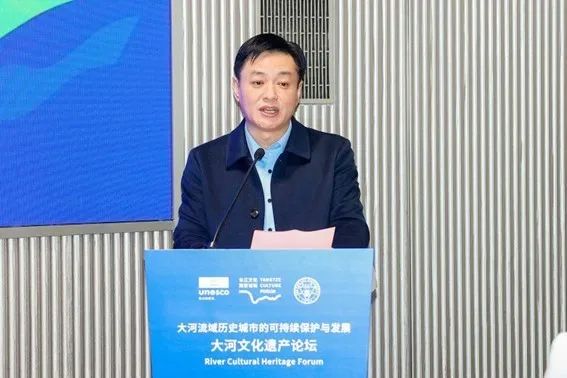
东南大学党委副书记,邢纪红 致辞
Xing Jihong, Deputy Secretary of the CPC Committee of Southeast University delivered welcome remarks
东南大学党委副书记邢纪红表示,对流域的历史城市研究不仅仅是对单一城市或村落历史的研究,也关系着区域统筹、城乡一体、历史景观、遗产及生态保护等各方面的重要课题。并希望本次论坛的成功举办能够充分挖掘长江文化资源的深厚底蕴和时代价值,推动大河流域历史文化保存与城市发展的和谐共生,展示中华文化独特魅力。
Xing Jihong, Deputy Secretary of the CPC Committee of Southeast University, said that the study of historic cities in the river basin was not only the study of the history of individual city or village, but also related to important topics such as regional coordination, urban-rural integration, historical landscape, heritage conservation and ecological protection . He also hoped that the successful holding of this forum could fully explore the profound foundation and contemporary value of the Yangtze River’s cultural resources, promote the harmonious coexistence of historical and cultural preservation and urban development in the great river basin, and demonstrate the unique charm of Chinese culture.
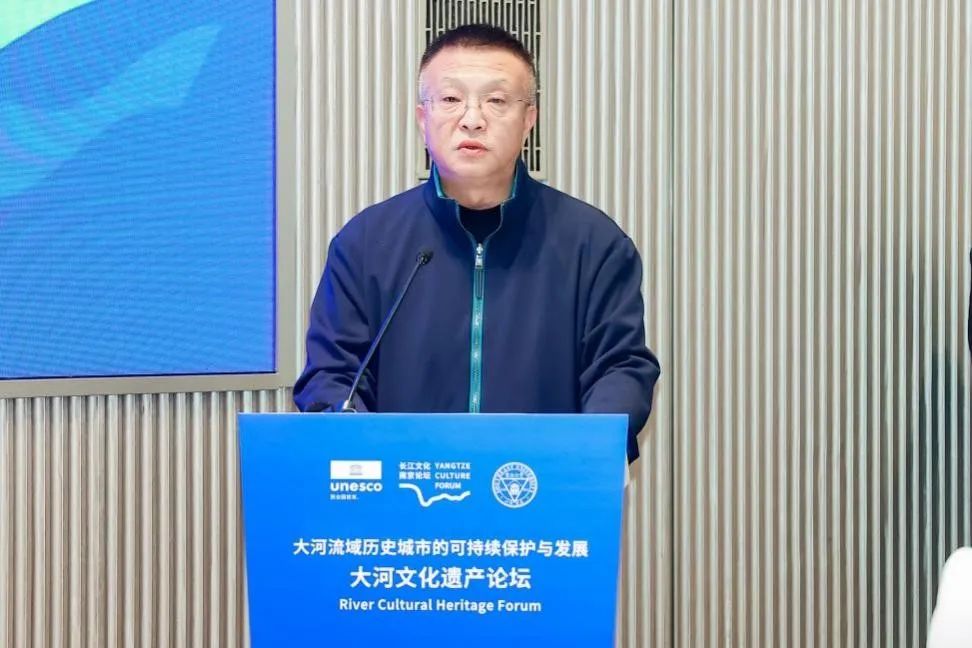
南京市规划和自然资源局副局长,刘青昊 致辞
Liu Qinghao,Deputy Director of the Nanjing Municipal Bureau of Planning and Natural Resources delivered welcome remarks
南京市规划和自然资源局副局长刘青昊强调了南京在长江流域中的作用,表示南京正从背江发展走向拥江发展,未来的南京滨江空间结构将呈现三大特色:蜿蜒壮美的生态自然景观,源远流长的历史文化资源,丰富多元的城市公共空间活动。并说明南京下一步将做好长江文化的传承和保护利用,将长江两岸塑造成集自然生态、历史人文、现代风尚为一体的国际一流滨水空间。
Liu Qinghao, Deputy director of the Nanjing Municipal Bureau of Planning and Natural Resources, emphasized the role of Nanjing in the Yangtze River basin, stating that Nanjing is moving from the ‘back-river development model’ to the ‘development with the river’. The future spatial structure of the Nanjing Riverside would present three major characteristics,including the magnificent ecological and natural landscape, the long-standing historical and cultural resources, and the rich and diversified urban public space activities. He also explained that Nanjing would take the next step of inheriting and preserving the Yangtze River culture, shaping both sides of the Yangtze River into an international first-class waterfront space that integrates natural ecology, history and humanities, and modern fashion.
02
颁奖仪式 Awarding Ceremony
在之后的颁奖仪式环节,主持人董卫介绍了联合国教科文组织亚太奖从成立到发展的历程以及遗产保护奖、创新奖、可持续发展奖的设立初衷。
Dong Wei presided the awarding ceremony and introduced the history of the UNESCO Asia-Pacific Awards from its establishment to its development and the original intention of the Heritage Conservation Award, Innovation Award and Sustainable Development Award.

联合国教科文组织曼谷办事处文化部主任,景峰 致辞
Jing Feng, Chief of Cultural Unit, UNESCO Regional Office in Bangkok Video Remark
联合国教科文组织曼谷办事处文化部主任景峰在视频致辞中强调流域文化遗产保护的重要性以及该论坛的重要性,并对历年获奖项目进行总结,以及对小西湖街区和贵州西里弄两个获奖项目进行介绍。
Jing Feng, Chief of Cultural Unit, UNESCO Regional Office in Bangkok, highlighted the importance of the conservation of cultural heritage in the basin and the importance of the forum in his remark. He also summarized the award-winning projects, and introduced the two award-winning projects of the current events——Nanjing Xiaoxihu Block and West Guizhou Lilong Neighborhood in Shanghai.

联合国教科文组织亚太地区文化遗产保护奖评审团成员, 游慧瑜 宣读获奖评语
Announcement by Anna Yau,Jury Member of UNESCO Asia-Pacific Awards for Cultural Heritage Conservation
教科文组织遗产奖评委团成员游慧瑜宣读南京小西湖和上海贵州西里弄获奖词,并由东南大学党委副书记邢纪红、南京市规划和自然资源局副局长刘青昊进行颁奖。
Anna Yau,Jury Member of UNESCO Asia-Pacific Awards for Cultural Heritage Conservation, read out the awarding comments for Nanjing Xiaoxihu Block and West Guizhou Lilong Neighborhood in Shanghai, and the awards were presented by Xing Jihong and Liu Qinghao.
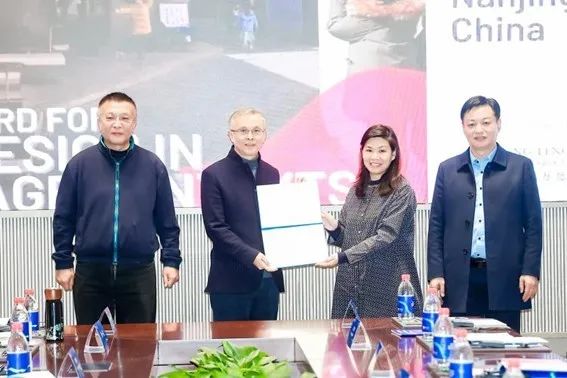
2022年历史环境中的创新设计奖: 小西湖街区,南京,
New Design in Heritage Contexts 2022:Xiaoxihu Block, Nanjing
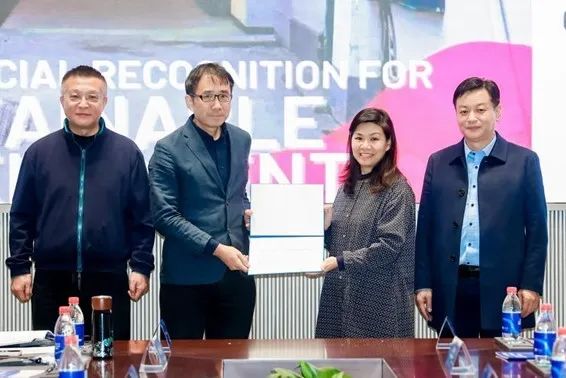
2022年可持续发展特别表彰奖: 贵州西里弄,上海
Special Recognition for Sustainable Development:West Guizhou Lilong Neighborhood, Shanghai
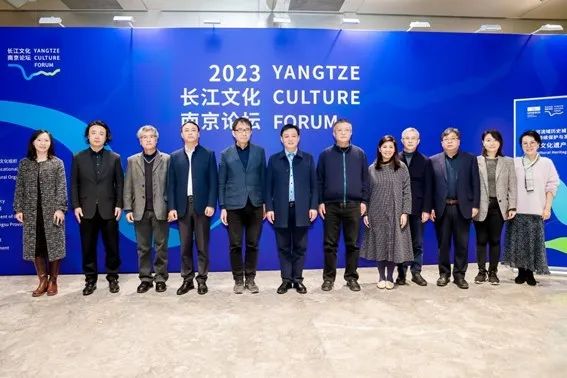
合影
Group Photo
小西湖街区实践是一场具有变革性的“公共-私人-居民”合作项目,展示了一种多管齐下复兴南京历史地段的方式。在社会和技术创新方面提供了可复制的重要经验,以整体和综合的方式提升了历史地段的宜居性。
贵州西里弄更新项目使用当代建筑设计手法强化了上海一个历史街区的社会和城市肌理。该项目采用了自下而上的设计方法,在了解当地居民的需求之后,巧妙地构思了新建筑和街道方案来升级社区设施。
The Xiaoxihu Block initiative is a transformative public-private-people partnership project demonstrating a multi-pronged approach to revitalizing a historic district in Nanjing. The project offers important lessons for replicability in terms of social and technical innovation for enhancing the livability of historic districts in a holistic and integrated manner.
The West Guizhou Lilong project is commended for applying thoughtful contemporary design to strengthen the social and urban fabric of a historic district in Shanghai.The project adopted a bottom-up approach to understand the needs of local residents before conceptualizing subtle new architectural and streetscape proposals for upgrading communal facilities.
03
主题分享 Keynote Speech

李向东,大河流域特色文化遗产保护与思考——长江流域文物保护为例
Li Xiangdong, Conservation and Reflections on the Characteristic Cultural Heritage of the Great River Basin-Case Study of Cultural Relics Conservation in the Yangtze River Basin
由中国文化遗产研究院副院长,国家文物局专家库专家、中国文物学会专家李向东先生首先进行主旨报告 ——《大河流域特色文化遗产保护与思考——长江流域文物保护为例》,分别从长江流域文物保护工作背景;长江流域的地域、空间及文物资源分布;长江流域文物资源特色;长江不同点段的文物资源特色——以江苏省为例;整体保护、系统保护、微观保护;行动思考六个方面进行讨论,勾勒出一幅长江文化带全景图。
Li Xiangdong, Vice Dean of the Chinese Academy of Cultural Heritage; Expert in the National Cultural Heritage Administration Database and China Cultural Relics Academy, first delivered the keynote speech of“Conservation and Reflections on the Characteristic Cultural Heritage of the Great River Basin-Case Study of Cultural Relics Conservation in the Yangtze River Basin”. The report respectively discussed from six perspectives,including ‘Background of Yangtze River Basin heritage conservation work’, ‘Geographical, spatial and cultural heritage resources distribution in the Yangtze River Basin’, ‘Characteristics of cultural relics resources in the Yangtze River Basin’, ‘Characteristics of cultural heritage resources in different point sections of the Yangtze River - Jiangsu Province as an case’; ‘Overall conservation,systematic and micro-conservation’; and ‘Reflection on Actions’, which outlined a panoramic picture of the Yangtze River Cultural Belt.

童明,横向文明、纵向文化
Tong Ming, Crosswise Civilization, Endwise Culture
东南大学建筑学院教授,英国皇家特许建筑师童明在《横向文明、纵向文化》中以衰退的城市空间为引,指出运河以及它的关联系统在当前由高速公路和铁路所形成的系统之外,形成了河运系统这一地理图景,以及由此串联而来的很多自然地景、文化设施与城市。
同时,童明指出河运系统目前面临的问题——在全球化与工业技术发展的过程中,河运系统所形成的纵向格局正逐渐被消隐,其串联的城市在今天逐渐淡化。这种原由河流和水运所构成的历史和城镇的景观在今天正趋于消失,仅保留微观的痕迹。要通过被动措施和主动工作去保持和发展,与我们生活紧密相关的区域可能是未来发展更加重要的节点。
最后,童明指出大河流域的文化性或者社会经济文化综合性的发展,除了对于历史因素的强化之外,实际上同样也要注重新的功能化的发展以及整体生态文明的延续。
Tong Ming, Professor of the School of Architecture, Southeast University; RIBA Chartered Architect;Chief Architect of TM Studio, Shanghai, in “Crosswise Civilization, Endwise Culture”, he took the declining urban space as a guide, indicating that the canal and its associated systems form a geographic picture of the river system in addition to the current system formed by motorways and railways, as well as the many natural landscapes, cultural facilities and cities connected by it.
Meanwhile, Prof.Tong noted that the current issues faced by the river transport system——in the process of globalization and the development of industrial technology, the vertical pattern formed by the river transportation system was gradually eliminated, and cities it linked were also fading away. This historical and urban landscapes originally constituted by rivers and waterways have gradually disappeared. To be preserved and developed through both reactive measure and proactive work, the areas that were closely related to our lives may be even more important nodes for future development.
Finally, Prof.Tong pointed out that in addition to strengthening historical factors, the culturality or socio-economic and cultural integration of river basins should also focus on the development of new functionalities and the continuation of the overall ecological civilization.
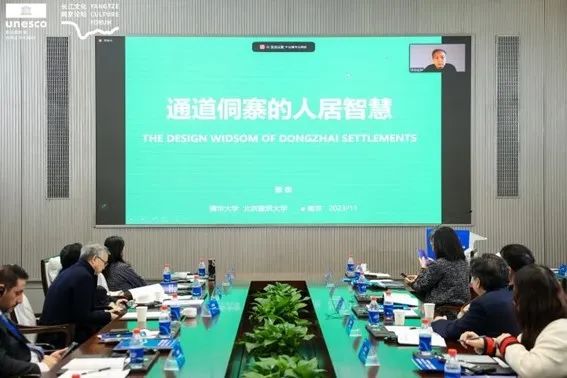
张杰,通道侗寨的人居智慧
Zhang Jie, The Design Wisdom of Dongzhai Settlement
清华大学建筑学院教授、全国工程勘察设计大师、国际古迹遗址理事(ICOMOS) 终身荣誉会员张杰在《通道侗寨的人居智慧》中深入性的对侗寨的发展背景、地理环境、社会组织下的村落选址和利用、水资源的利用和管理、村寨节地的聚落布局模式、内部组织等内容进行分析,展现出一幅少数民族地区聚落,以及聚落文化发展的态势。
Zhang Jie,Professor of School of Architecture, Tsinghua University, National First-Class Registered Architect, Honorary Membership of ICOMOS, in “the Design Wisdom of Dongzhai Settlement”,he conducted an in-depth analysis of the the Dong minority’s settlements from their development background, geographical environment, site selection, utilization and management of the water resource, settlement layout model of village land-saving, internal organization and other factors. The report displayed a picture for the development of settlements in ethnic minority areas, as well as with the development trend of settlement culture.
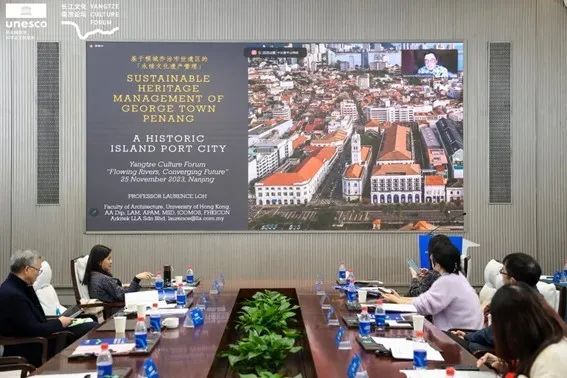
Laurence Loh,槟城州乔治市的可持续遗产管理:历史悠久的岛屿港口城市
Laurence Loh, Sustainable Heritage Management of George Town, Penang: A Historic Island Port City
Akitek ALLA首席建筑师、Akitek建筑师事务所负责人、联合国教科文组织亚太地区文化遗产保护奖评审团成员Laurence Loh在《槟城州乔治市的可持续遗产管理:历史悠久的岛屿港口城市》中对基于槟城州乔治市宜居的可持续文化遗产管理进行了讨论,表达了保护文化资产、文化权益,保留历史的社区和历史遗产的愿景。之后展示了马来西亚槟城州乔治市发展的过程,以及从申遗以前到现在遗产保护所面临的挑战,这反映出在整个亚洲快速和大规模城市化进程中,历史城市保护与发展所面临的共同问题。
Laurence Loh, Principal and Principal Architect of Akitek LLA;Jury Member of UNESCO Asia-Pacific Awards for Cultural Heritage Conservation, discussed sustainable cultural heritage management based on the livability of George Town in " Sustainable Heritage Management of George Town, Penang: A Historic Island Port City", expressing the vision of conserving cultural assets, cultural rights and interests, and preserving historic communities and heritage. This was followed by the development process of George Town, Penang State, Malaysia, and the challenges faced by heritage conservation from pre-inscription period to the present, which reflected the common issues facing the preservation and development of historic cities in the midst of rapid and massive urbanization throughout Asia.

东南大学建筑学院副院长,江泓
Jiang Hong, Vice Dean and Associate Professor of School of Architecture, Southeast University
东南大学建筑学院副院长江泓主持下午的主题分享和研讨会环节。
Jiang Hong, Vice Dean and Associate Professor of School of Architecture, Southeast University, moderated the keynote speech and seminar session in the afternoon.
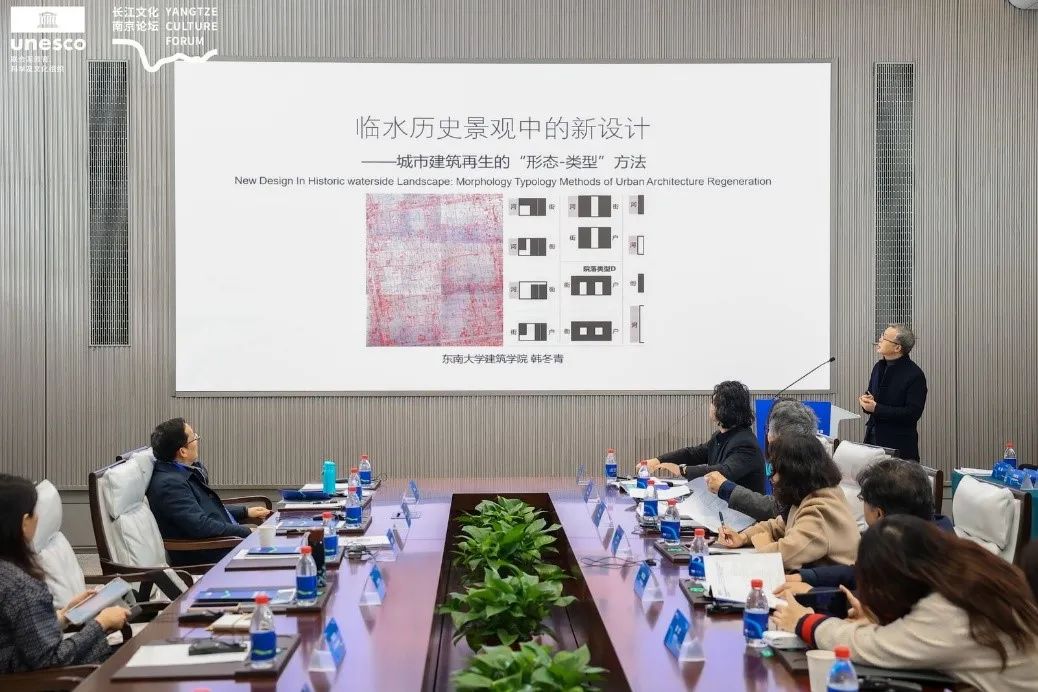
韩冬青,临水历史景观中的新设计——城市建筑再生的“形态-类型”方法
Han Dongqing, New Design of Waterfront Historic Landscape: A “Morphology-Typology” Approach for Urban Architectural Regeneration
东南大学建筑学院教授、全国工程勘察设计大师、东南大学建筑设计研究院总建筑师韩冬青的报告题目是《临水历史景观中的新设计——城市建筑再生的“形态-类型”方法》,从微观环境探究地段形态结构和地方空间建筑的类型或者活动场所的特性之间的关系,并选取小西湖街区、秦淮河西五华里滨河地段、“水木秦淮”和钟山“旅游市集”四个分布在南京环城水系不同位置的案例,具体讨论不同历史环境管控要求下的建筑设计响应,通过历史研究对微观地块中的稳定结构特征和内生逻辑进行保护与再生思考。
Han Dongqing, Professor of School of Architecture, Southeast University; National Engineering Exploration and Design Master; Chief Architect, Architects & Engineers Co., Ltd. of Southeast University, gave a report entitled "New Design of Waterfront Historic Landscape: A ‘Morphology-Typology’ Approach for Urban Architectural Regeneration". He explored the relationship between the morphological structure of the site and the types of local spatial architecture from the micro-environment,or the relationship between the characteristics of activity venues, and he selected four cases distributed in different locations of Nanjing’s ring water system, including the Xiaoxihu Block, the West Wuhuali in riverfront section of Qinhuai River, "Shuimu Qinhuai" and Zhongshan "Tourist Market". He specifically discussed architectural design responses to the requirements of the different historical environmental management and control, and to reflect on the conservation and regeneration of stable structural characteristics and endogenous logic in micro-plots through historical research.
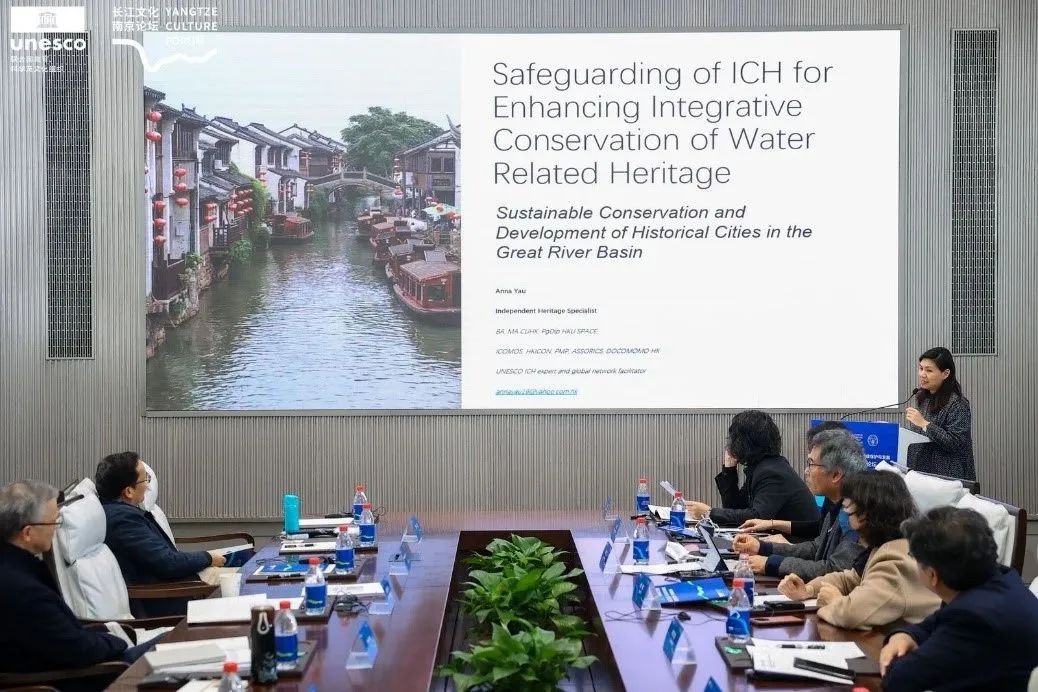
游慧瑜,保护非物质文化遗产以加强与水有关的遗产的综合保护
Anna Yau, Safeguarding of ICH for Enhancing Integrative Conservation of Water Related Heritage
联合国教科文组织亚太地区文化遗产保护奖评审团成游慧瑜发表题为《保护非物质文化遗产以加强与水有关的遗产的综合保护》的报告。人与自然长期互动而形成的习俗习惯、历史文化的结晶最后凝结为物质形态,构成了物质空间的遗存,也蕴含着场所精神和地方文化认同。但现代化浪潮不可避免对物质文化遗存带来了结构性老化和功能性衰退的冲击,空有躯壳的文化遗产是否仍有意义,折损的文化信息和价值是否仍能在如水资源的简单但重要的载体上满足遗产保护和可持续发展目标。
Anna Yau, Jury Member of UNESCO Asia-Pacific Awards for Cultural Heritage Conservation, delivered a report titled "Safeguarding of ICH for Enhancing Integrative Conservation of Water Related Heritage" . Customs and habits formed through the long-term interaction between human and nature, and the crystallization of history and culture, ultimately condensed into material forms, forming the remains of the material space and containing the spirit of the place and local cultural identity. However, the wave of modernization had inevitably brought about the impact of structural aging and functional decline on material cultural relics, whether the empty cultural heritage still meaningful, and whether the depreciated cultural information and values could still meet heritage conservation and sustainable development goals in simple but vital carrier such as water resources.

Marie-Noel Tournoux,遗产价值与城镇发展融合
Marie-Noel Tournoux,Project Director WHITRAP Shanghai, China
《遗产价值与城镇发展融合》由联合国教科文组织亚太地区世界遗产培训与研究中心(上海)项目主任Marie-Noel Tournoux在线上参会作出全景式分享。首先系统性梳理了水跟历史环境的关系,其包含在人类的生产活动,包含在生活和生态体系,也包含在由自然遗产和文化遗产共同构成的历史进程中;其次强调了文化遗产不是发展的负担,而是发展的动力。因而,在历史进程中展现的与水交织的不同类型文化遗产都不能够忽视对其的多视角关注、保护和发展。
"Integrating Heritage Values in Development Processes" was presented by Marie-Noel Tournoux, Project Director WHITRAP Shanghai, China. Firstly, she systematically sorted out the relationship between water and the historical environment, which was include in human production activities, life and ecological systems, and in the historical process composed of natural heritage and cultural heritage. Secondly, she emphasized that cultural heritage was not a burden for development, but the driving force for development. Consequently, it was crucial that various forms of cultural heritage that were intertwined with water throughout history get multifaceted attention, conservation and development.
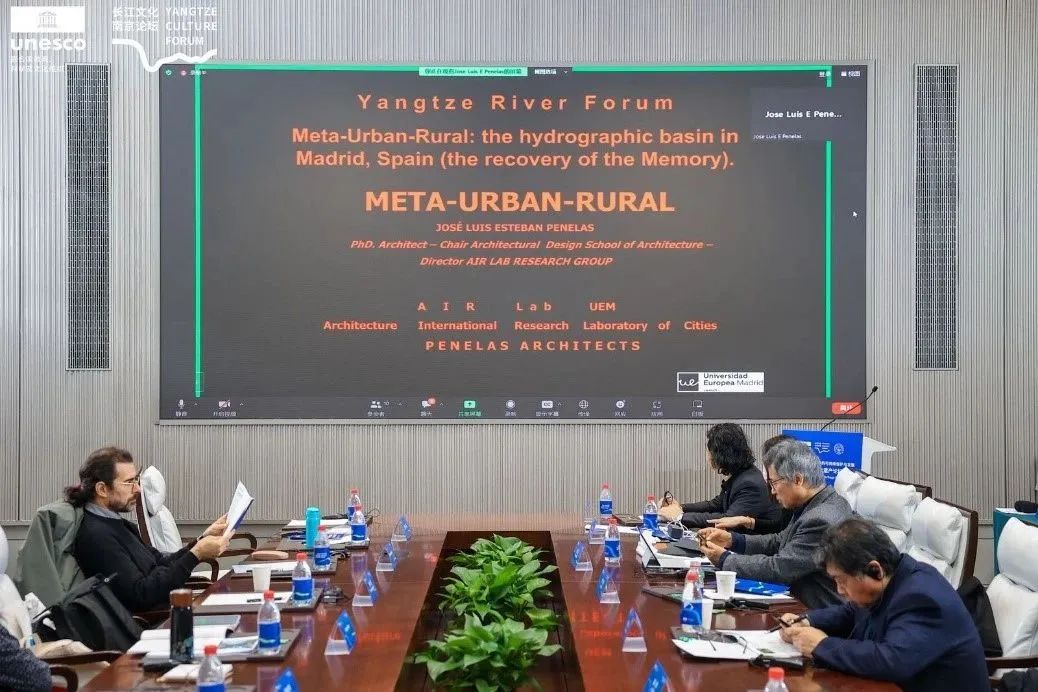
Jose Luis Esteban Penelas,城乡之间:西班牙马德里的水文盆地
Jose Luis Esteban Penelas, Meta-Urban-Rural: the Hydrographic Basin in Madrid, Spain (the Recovery of the Memory)
西班牙马德里欧洲大学建筑、工程及设计学院讲席教授、国际城市设计及建筑研究组组长Jose Luis Esteban Penelas和《城乡之间:西班牙马德里的水文盆地》报告在历史本底上试图去重建地方感和地方性,使水文盆地重新恢复其承载文化的职能,也随着现代因素的植入和艺术氛围的加入,兼具地方文化认同和服务公众的场所空间被建立,成为对自然河道、城市都是为未来提供非常宝贵的资产。
Jose Luis Esteban Penelas, Chair Professor of School of Architecture, Engineering and Design, Universidad Europea de Madrid; Head of Design Studio Department, Director of Grupo de Investigación AIR Lab (Architectural International Research Laboratory of Cities Design Institute Research Group); Founder of Penelas Architects, and his report "Meta-Urban-Rural: the Hydrographic Basin in Madrid, Spain (the Recovery of the Memory) " attempted to reconstruct a sense of place and locality based on the historical background, which allowed the hydrological basin to regain its function of carrying culture. Moreover, with the implantation of modern factors and the addition of artistic atmosphere, a place and space for both local cultural identity and service to the public had been established, which had become an invaluable asset for the natural river and the city for the future.
04
讨论 Discussion
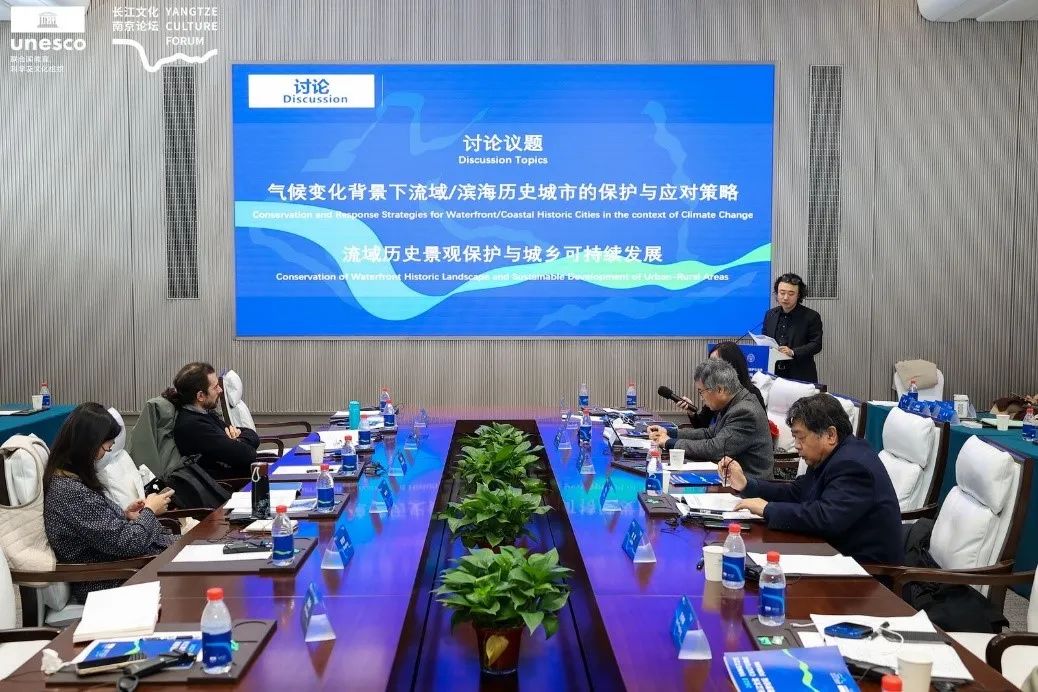
讨论议题
Discussion Topics
面向过去的阐释、未来的创造,研讨嘉宾就气候变化背景下流域/滨海历史城市的保护与应对策略,以及流域历史景观保护与城乡可持续发展两个议题展开讨论。
Towards the interpretation of the past and the creation of the future, the discussion focused on two topics: Conservation and Response Strategies for Waterfront/Coastal Historic Cities in the context of Climate Change, and Conservation of Waterfront Historic Landscape and Sustainable Development of Urban-Rural Areas.
李百浩老师行诉了对于江河等文化分区的一系列文化想象和文化延伸的思考,在此基础上,因流域的广泛性和地区性特征,我们需要更深入的整体性认知去适应国土空间规划和高质量发展需求。Anna Yau建议提高人们的意识,推广教育项目,形成一种水的素养,推动水资源和水文化的保护。Sinan Burat认为建造的文化或视野也是生态场所,但气候变化迫使我们放弃这些文化遗产;因而在人造环境并非独立的情况下,我们不能打破人造场所和水系统、生态的平衡,否则我们没有未来。董卫老师也回顾城市规划发展史,肯定了对于城市而言,资源约束,防灾防洪要求或是发展瓶颈,水都是首要考虑要素,正如城市的选址、文明的诞生就与水密不可分。最后,何依老师就水与城市、文化的关系做出总结,任何地区均可以演化出独特的人和水共生共存的历史。人和水的斗争,人和水相互利用,人和水相互交融的关系,都值得我们在不同维度上进行探究。
Prof. Li Baihao expressed a series of reflections on the cultural imagination and extension of thoughts on rivers and other cultural divisions, based on which, due to the wide-ranging and regional characteristics of the river basin, we need a deeper holistic understanding to adapt to the needs of territorial spatial planning and high-quality development. Anna Yau recommended raising people's awareness and promoting educational programmes to create a water literacy, which would promote the conservation of water resources and water culture. Prof. Sinan Burat believed that building culture or horizons were also ecological venues, but climate change was forcing us to abandon these cultural heritages, thus,we could not break the balance of artificial places, water systems and ecology, when the artificial environment was not independent, otherwise we had no future. Prof. Dong Wei reviewed the history of urban planning development, and affirmed that for cities, water was the primary consideration for cities in terms of resource constraints, disaster and flood prevention requirements, or bottlenecks in development course, just as water was inextricably linked to the location of cities and the birth of civilizations. Finally, Prof. He Yi summarized the relationship between water, cities and culture, arguing that any region could evolve a unique history of coexistence between people and water, the struggle between human and water, the mutual use of human and water, and the relationship between human and water were all worth exploring in different dimensions.

李百浩教授发言
Prof. Li Baihao
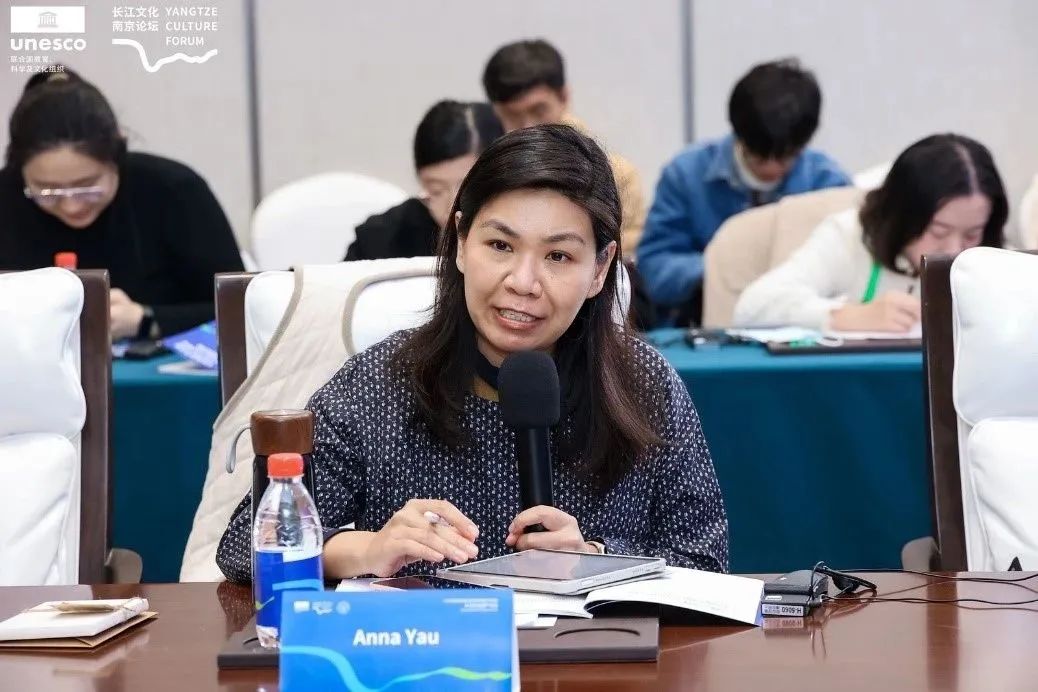
游慧瑜发言
Anna Yau

Sinan Burat教授发言
Prof. Sinan Burat

董卫教授发言
Prof. Dong Wei

何依教授发言
Prof. He Yi
信息来源:联合国教科文组织 国际文化遗产保护与修复研究中心-亚洲遗产管理学会秘书处、城市规划系党支部



